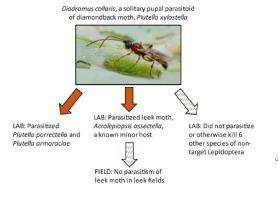Biological Control ( IF 4.2 ) Pub Date : 2021-07-05 , DOI: 10.1016/j.biocontrol.2021.104705 Christine Cock 1, 2 , Peter G. Mason 1 , Tim Haye 3 , Naomi Cappuccino 2

|
Before a non-native agent is introduced for the classical biological control of a pest, its host specificity must be determined. We assessed the host specificity of Diadromus collaris (Gravenhorst) (Hymenoptera: Ichneumonidae), a solitary pupal endoparasitoid being considered for biological control of the diamondback moth Plutella xylostella (Linnaeus) (Lepidoptera: Plutellidae) in Canada. In black-box no-choice tests on nine non-target species, D. collaris successfully parasitized other species in the genus Plutella (the introduced Plutella porrectella Linnaeus and the native Plutella armoraciae Busck) as well as another introduced agricultural pest, the leek moth Acrolepiopsis assectella (Zeller) (Lepidoptera: Glyphipterigidae). This suggests that the fundamental host range of D. collaris includes other species in the Plutellidae, as well as Glyphipterigidae that are ecologically and morphologically similar to diamondback moth. Field tests in Switzerland comparing parasitism by D. collaris on sentinel diamondback moth pupae and leek moth pupae in both canola and leek fields revealed no parasitism of leek moth in leek fields, indicating that the ecological host range of D. collaris is in fact more restricted. Because of this, it would be premature to discount D. collaris as a potential biological control agent for diamondback moth in Canada.
中文翻译:

确定加拿大小菜蛾 Plutella xylostella linnaeus(鳞翅目:小菜蛾科)的候选生物防治剂Diadromus collis (Gravenhorst)(膜翅目:Ichneumonidae)的寄主范围
在引入非本地病原体对有害生物进行经典生物防治之前,必须确定其寄主特异性。我们评估了Diadromuscollis (Gravenhorst)(膜翅目:Ichneumonidae)的宿主特异性,这是一种孤立的蛹内寄生物,被考虑用于加拿大小菜蛾Plutella xylostella(Linnaeus)(鳞翅目:Plutellidae)的生物控制。在对九个非目标物种的黑盒无选择测试中,D.collis成功寄生了小菜蛾属的其他物种(引入的Plutella porrectella Linnaeus 和本地的小菜蛾Plutella armaciae Busck)以及另一种引入的农业害虫韭菜蛾Acrolepiopsis assectella (Zeller) (鳞翅目:Glyphipterigidae)。这表明D.collis的基本宿主范围包括 Plutellidae 中的其他物种,以及在生态和形态上与小菜蛾相似的 Glyphipterigidae。在瑞士的田间试验中,在油菜田和韭菜田中比较了D.collis对哨兵小菜蛾蛹和韭菜蛾蛹的寄生情况,结果表明韭菜田中没有韭菜蛾寄生,表明D.collis的生态寄主范围实际上受到了更多限制. 因此,将D.collis视为加拿大小菜蛾的潜在生物防治剂还为时过早。



























 京公网安备 11010802027423号
京公网安备 11010802027423号